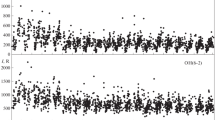Abstract
The problem of systematic overestimation (20–50%) of the retrieved ozone concentrations in the altitude range of 60–80 km in the TIMED–SABER satellite experiment in the daytime has been solved. The reason for overestimation is the neglect of the electronic vibrational kinetics of photolysis products of ozone and molecular oxygen O2(b1Σg +, ν) and O2(a1Δg, ν). The IR emission band of O2(a1Δg, ν = 0) at 1.27 μm can be correctly used in remote sensing in order to obtain the ozone altitude profile in the altitude range of 50–88 km only with the use of a complete model of electronic vibrational kinetics of O2 and O3 photolysis products (YM2011) in the Earth’s mesosphere and lower thermosphere. Alternative ozone tracers have been considered, and an optimum tracer in the altitude range of 50–100 km such as O2(b1Σg +, ν = 1) molecule emissions has been proposed.
Similar content being viewed by others
References
Dylewski, S.M., Geiser, J.D., and Houston, P.L., The energy distribution, angular distribution, and alignment of the O(1D2) fragment from the photodissociation of ozone between 235 and 305 nm, J. Chem. Phys., 2001, vol. 115, pp. 7460–7473.
Feofilov, A.G. and Kutepov, A.A., Infrared radiation in the mesosphere and lower thermosphere: Energetic effects and remote sensing, Surv. Geophys., 2009, vol. 33, no. 6, pp. 1231–1280. doi 10.1007/s10712-012-9204-0
Feofilov, A.G., Kutepov, A.A., Garcia-Comas, M., et al., Daytime SABER/TIMED observations of water vapor in the mesosphere: Retrieval approach and first results, Atmos. Chem. Phys., 2009, vol. 9, pp. 8139–8158. doi 10.5194/acp-12-9013-2012
Mlynczak, M.G., Marshall, B.T., Martin-Torres, F.J., Russell, J.M., Thompson, R.E., Remsberg, E.E., and Gordley, L.L., Sounding of the atmosphere using broadband emission radiometry observations of daytime mesospheric O2(1Δ) 1.27 μm emission and derivation of ozone, atomic oxygen, and solar and chemical energy deposition rates, J. Geophys. Res.: Atmos., 2007, vol. 112, D15306. doi 10.1029/2006JD008355
Mlynczak, M.G., Solomon, S.C., and Zaras, D.S., An updated model for O2(a1Δg) concentrations in the mesosphere and lower mesosphere and implications for remote sensing of ozone at 1.27 μm, J. Geophys. Res.: Atmos., 1993, vol. 98, pp. 18639–18648.
SABER V2.0, 2015. http://saber.gats-inc.com/data.php.
Smith, A.K., Harvey, V.L., Mlynczak, M.G., et al., Satellite observations of ozone in the upper mesosphere, J. Geophys. Res.: Atmos., 2013, vol. 118, pp. 5803–5821. doi 10.1002/jgrd.50445
Thelen, M.-A., Gejo, T., Harrison, J.A., and Huber, J.R., Photodissociation of ozone in the Hartley band: Fluctuation of the vibrational state distribution in the O2(a1Δg, ν) fragment, J. Chem. Phys., 1995, vol. 103, pp. 7946–7955.
Valentini, J.J., Gerrity, D.P., Phillips, D.L., Nieh, J.-C., and Tabor, K.D., CARS spectroscopy of O2(a1Δg) from the Hartley band photodissociation of O3: Dynamics of the dissociation, J. Chem. Phys., 1987, vol. 86, pp. 6745–6756.
Yankovsky, V. A. and Kuleshova, V.A., Ozone photodissociation at excitation within the Hartley absorption band. Analytical description of quantum yields O2(a1Δg, ν = 0–3) depending on the wavelength, Opt. Atmos. Okeana, 2006, vol. 19, no. 7, pp. 514–518.
Yankovsky, V.A. and Manuilova, R.O., Model of daytime emissions of electronically–vibrationally excited products of O3 and O2 photolysis: Application to ozone retrieval, Ann. Geophys., 2006, vol. 24, no. 11, pp. 2823–2839. doi 10.5194/angeo-24-2823-2006
Yankovsky, V.A. and Babaev, A.S., Photolysis of O3 at Hartley, Chappuis, Huggins, and Wulf bands in the middle atmosphere: Vibrational kinetics of oxygen molecules O2(X3Σg -, ν ≤ 35), Atmos. Oceanic Opt., 2011, vol. 24, no. 1, pp. 6–16. doi 10.1134/S1024856011010155
Yankovsky, V.A., Kuleshova, V.A., Manuilova, R.O., and Semenov, A.O., Retrieval of total ozone in the mesosphere with a new model of electronic–vibrational kinetics of O3 and O2 photolysis products, Izv., Atmos. Ocean. Phys., 2007, vol. 43, no. 4, pp. 514–525.
Yankovsky, V.A., Manuilova, R.O., Babaev, A.S., Feofilov, A.G., and Kutepov, A.A., Model of electronic–vibrational kinetics of the O3 and O2 photolysis products in the middle atmosphere: Applications to water vapour retrievals from SABER/TIMED 6.3 μm radiance measurements, Int. J. Remote Sens., 2011, vol. 33, pp. 3065–3078. doi 10.1080/01431161.2010.541506
Yankovsky, V.A., Martyshenko, K.V., Manuilova, R.O., and Feofilov, A.G., Oxygen dayglow emissions as proxies for atomic oxygen and ozone in the mesosphere and lower thermosphere, J. Mol. Spectrosc., 2016, vol. 327, pp. 209–231. doi 10.1016/j.jms.2016.03.006
Author information
Authors and Affiliations
Corresponding author
Additional information
This work is dedicated to the memory of the Russian scientist Nikolai Nikolaevich Shefov
Original Russian Text © K.V. Martyshenko, V.A. Yankovsky, 2017, published in Geomagnetizm i Aeronomiya, 2017, Vol. 57, No. 2, pp. 249–261.
Rights and permissions
About this article
Cite this article
Martyshenko, K.V., Yankovsky, V.A. IR band of O2 at 1.27 μm as the tracer of O3 in the mesosphere and lower thermosphere: Correction of the method. Geomagn. Aeron. 57, 229–241 (2017). https://doi.org/10.1134/S0016793217020098
Received:
Published:
Issue Date:
DOI: https://doi.org/10.1134/S0016793217020098




